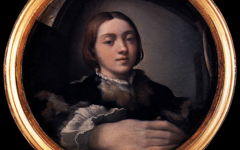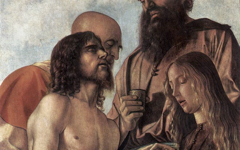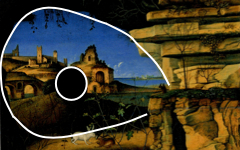Bellini’s Madonna of the Pear (c.1485)

Bellini, Madonna of the Pear (c.1485) Bergamo, Galleria dell'Accademia Carrara
Click image to enlarge.
Keith Christiansen's useful survey of Giovanni Bellini’s large output of half-length images of the Virgin explains the rapidly growing practice of worshipping in private, a trend which helped foster (though he does not say so) the Inner Tradition by encouraging Christians to question their faith and the meaning of Scripture. Bible-reading increased throughout the fifteenth century and images like these (left), designed for private devotion, were said to help spur the practitioner to focus inwards.
Click next thumbnail to continue
Christiansen criticizes Bellini for “curiously lacking in programmatic invention” and claims that there is no pun in Bellini's art like that in Leonardo’s Madonna of the Yarnwinder where the infant Christ is caught in the act of recognizing that the cruciform-shape of his mother’s yarnwinder foretells his own fate.2 The comparison is unfair to Bellini because, clever as Leonardo's pun is, it is fairly obvious. We can all see it, most of us without help. Some of Bellini’s puns, though, like Leonardo’s too for that matter, are less easy to identify and were mainly intended for “initiates” like other artists. Some have never been seen before.3
Click next thumbnail to continue

Bellini, Madonna of the Pear (c.1485) Bergamo, Galleria dell'Accademia Carrara
Click image to enlarge.
Take, for instance, Bellini’s subtle suggestion in the Madonna of the Pear (left) that creativity is a feminine principle and that the Virgin's Immaculate Conception of Christ is comparable to the artist's own. It may also indicate that Christ - though male - was androgynous in spirit as should be any mind that seeks unity with the Godhead.
Click next thumbnail to continue
There to the left of Christ’s hidden phallus is a crease in Christ's thigh intentionally resembling a vagina, a vagina moreover placed in front of the Virgin’s womb. Christ, as a representation of the artist's true Self, conceives like an artist. The crease of the vagina is "hidden" not to turn its discovery into a game but to make clear, perhaps, that only an inquiring mind, willing to question the illusion of “reality”, will find truth and permanent reality in God. Whatever their exact meaning, Bellini's illusions are more inventive than the yarnwinder.
More Works by Bellini
Notes:
1. Keith Christiansen, "Giovanni Bellini and the Practice of Devotional Painting" in Giovanni Bellini and the Art of Devotion (Indianapolis Museum of Art) 2004, pp.7-59
2. ibid., p. 29
3. See, for instance, the "hidden" eyeball in Bellini's The Frari Triptych
Original Publication Date on EPPH: 10 Jul 2011. | Updated: 0. © Simon Abrahams. Articles on this site are the copyright of Simon Abrahams. To use copyrighted material in print or other media for purposes beyond 'fair use', you must obtain permission from the copyright owner. Websites may link to this page without permission (please do) but may not reproduce the material on their own site without crediting Simon Abrahams and EPPH.





